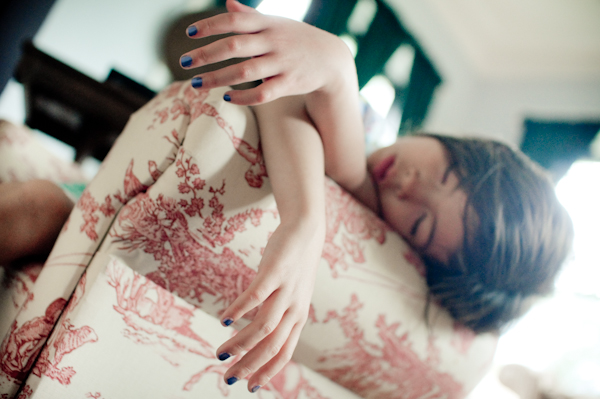sunday school: a little tilt goes a long way
 Sunday, June 6, 2010 by
Sunday, June 6, 2010 by  sarah-ji
sarah-ji 
This is a picture of sheer exhaustion. After a fun-filled birthday party complete with jumpy castle and a Darth Vader piñata, too little food and too much sweets, we slowed down at home by painting her nails. So there she sat in her chair, carefully holding her hands just so to avoid smudging the fresh sparkly polish, when she just couldn't keep her head up any longer and she fell into a much needed slumber. After my initial response of a mother's adoring "Awww, my poor, tired child," I did what any sensible Shutter Sister would do and grabbed my camera.
It's not often that my girl will hold still to have her photo taken, so it was quite a treat to have the freedom to shoot away. I took about twenty pictures from different angles and distances, but none of the images stood out to me. On the very last shot that I took, I decided to tilt the camera a tad bit to make the framing less rectangular, and that ended up being the shot that I felt captured best what I wanted to convey, namely the haphazard placement of her hands and arms and head in a chaotic configuration that only children can happily sleep in.
This little tilt of the camera that forces the horizon to be at an angle to the bottom of the image frame (as opposed to parallel to it) is sometimes called the Dutch angle or Dutch tilt. I have found it quite useful in adding some visual appeal to an otherwise bland image. I try to use it sparingly, but when I do, more often than not, I love the result.
If you've never tried the Dutch angle, I highly recommend it the next time you're shooting portraits or even a still object. Play around with how your frame the shot (i.e., direction of the angle in relation to the subject, where the subject is placed in the composition, etc.), and you just might be pleasantly surprised. For some great examples, you need look no further than our own Shutter Sisters Flickr pool!
Are there any other camera tilters out there? Please share with us your favorite off-kilter shots!




